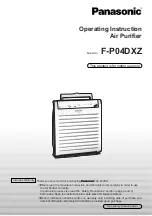
Page 8
# 48387H005
6. Set the recovery machine for liquid recovery and start
the recovery machine. Open the gauge set valves to
allow the recovery machine to pull a vacuum on the
existing system line set and indoor coil.
7. Invert the cylinder of clean R-22 and open its valve to
allow liquid refrigerant to flow into the system through
the suction line valve. Allow the refrigerant to pass
from the cylinder and through the line set and the
indoor coil before it enters the recovery machine.
8. After all of the liquid refrigerant has been recovered,
switch the recovery machine to vapor recovery so that
all of the R-22 vapor is recovered. Allow the recovery
machine to pull a vacuum on the system.
NOTE:
A single system flush should remove all of the
mineral oil from the existing refrigerant lines and indoor
coil. A second flushing may be done (using clean
refrigerant) if insufficient amounts of mineral oil were
removed during the first flush.
After each system
flush, allow the recovery machine to pull a vacuum
on the system at the end of the procedure.
9. Close the valve on the inverted R22 cylinder and the
gauge set valves. Pump the remaining refrigerant out
of the recovery machine and turn the machine off.
10. Use nitrogen to break the vacuum on the refrigerant lines
and indoor coil before removing the recovery machine,
When the low side system pressures reach 0 psig, close
the suction line valve. Disconnect all power to the
existing outdoor unit. Refer to the gauges after shutdown
to confirm that the valves are not allowing refrigerant to
flow back into the low side of the system. Disconnect the
liquid and suction lines from the existing outdoor unit.
2. Remove the existing outdoor unit. Set the new R410A
unit and follow the brazing connection procedure
outlined previously on this page to make line set
connections.
Do not install the R410A thermal
expansion valve at this time.
3. Make low voltage and line voltage connections to the
new outdoor unit.
Do not turn on power to the unit or
open the outdoor unit service valves at this time.
4. Remove the existing R-22 refrigerant flow control
orifice or thermal expansion valve before continuing
with flushing procedures. R-22 flow control devices
are not approved for use with R410A refrigerant and
may prevent proper flushing. Use a field-provided
fitting to reconnect the lines.
5. Remove the pressure tap valve cores from the
4SCU13LE unit’s service valves. Connect an R-22
cylinder with clean refrigerant to the suction service
valve. Connect the R-22 gauge set to the liquid line
valve and connect a recovery machine with an empty
recovery tank to the gauge set.
Figure 10
Flushing Connections
Note: The inverted R22 cylinder must contain
at least the same amount of refrigerant
as was recovered from the existing
system.






































